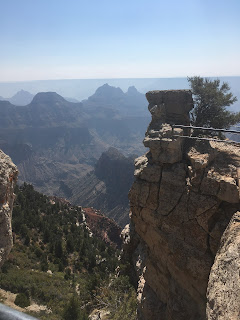Hello friends,
At the time I was writing my draft of this, I was in sunny California sitting in Joshua Tree National Park. Now I am in my kitchen after an October winter storm in Minneapolis. What a difference a few weeks can make! I am missing the desert heat quite a bit.
I found visiting the Petrified Forest and Painted Desert extremely unique experiences. Though there is petrified wood around the world, the quantity and quality of the formations and and colors of the wood had no match. There were plenty of signs and old tourist attractions surrounding the park that had seen better days as the area use to thrive on people traveling on Route 66. Paths throughout the park lead to various sites of large deposits of rainbow petrified wood that have been uncovered through erosion after millions of years. The Painted Desert shows these erosion as well, with its saturated and colorful layers unveiled across the landscape.
 |
| The insides of the petrified wood, essentially turned to quartz after millions of years. |
 |
| I was surprised how much the petrified wood still looked like wood! |
 |
| A petrified wood "bridge" named Agate Bridge. Water eroded the underside of this log away, and thought there are supports to preserve this monument, eventually it will break away. |
With the combination of the large swaths of fossilized forest, desolate desert, and neglected former tourist attractions of another era, the whole experience felt similar to visiting a graveyard of sorts - eerie, peaceful, quiet.
Arriving to the Grand Canyon brought me back to a familiar landscape of prairie and forest. Though still a dry and rocky climate, I camped in the Kaibab National Forest with towering birch trees and plentiful populations of deer and birds. Comparably, the desert felt so silent compared to the lifesounds of the forest.
The Canyon walls were higher up than I could have ever imagined, with many trails venturing along the edge. Due to the wildfires, the Grand Canyon had captured a lot of the haze, so one was not able to see out into the canyon as well. The heights and the elevation didn't always agree with me, but the carving of the canyon through the Colorado River over millions of years was a stark difference in the rock and mountain formations I had seen before, and would see in Zion.
Next - Joshua Tree, Zion, and Minnesota (home!)









No comments:
Post a Comment